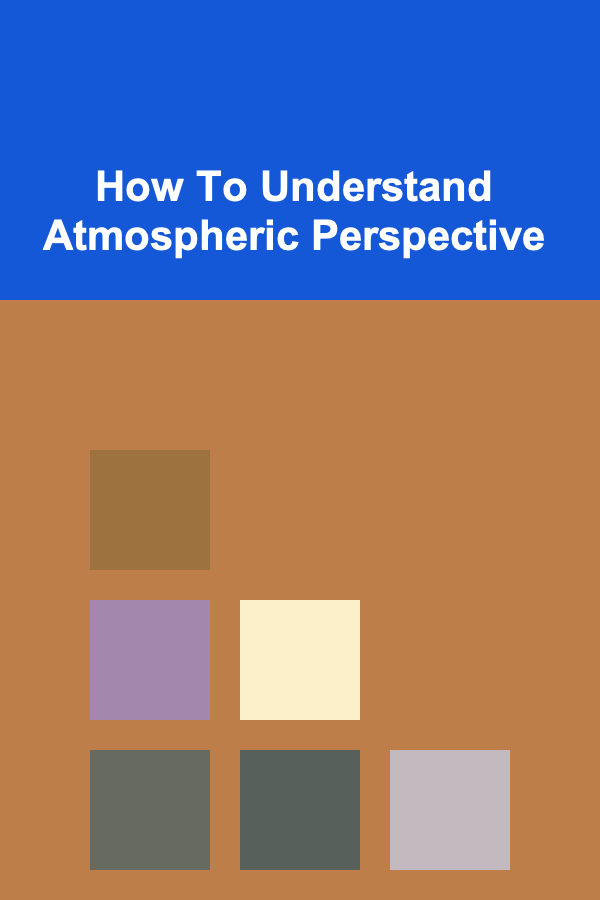
How To Understand Atmospheric Perspective
ebook include PDF & Audio bundle (Micro Guide)
$12.99$9.99
Limited Time Offer! Order within the next:

Atmospheric perspective, also known as aerial perspective, is a technique used in art to create the illusion of depth and distance in a two-dimensional work by depicting changes in color, tone, and clarity. It relies on the way the atmosphere affects the appearance of objects as they recede into the distance. Understanding atmospheric perspective not only enhances the quality of your artwork but also helps in appreciating the natural world in a more nuanced way.
In this article, we will dive into the concept of atmospheric perspective, how it functions in visual perception, and how you can apply it in your own artistic practices, whether in painting, photography, or even landscape design.
The Science Behind Atmospheric Perspective
To understand atmospheric perspective, it's important to first grasp the scientific principles behind it. The atmosphere, made up of gases like oxygen, nitrogen, and water vapor, scatters light. As objects move farther away from the observer, the layers of atmosphere between the viewer and the object increase, causing the light to scatter more.
This scattering has several effects:
- Reduced Contrast: Objects that are farther away appear lighter and less distinct because the air particles scatter the light, causing a reduction in contrast. In contrast, objects closer to the observer retain sharper edges and darker tones.
- Color Shift: The color of distant objects tends to shift toward blue or gray. This is because shorter wavelengths of light (like blue) scatter more than longer wavelengths (like red and yellow), giving distant objects a cooler, bluer hue.
- Loss of Detail: As the distance between the observer and an object increases, fine details become harder to distinguish. This is because the fine particles in the atmosphere block some of the light and obscure the sharpness of the object's edges.
In art, these principles are applied to create a sense of depth and space. By simulating the way the atmosphere interacts with light and distant objects, artists can mimic the way the human eye perceives the world.
The Key Elements of Atmospheric Perspective
1. Tone and Value
One of the most effective ways to depict atmospheric perspective is through the manipulation of tone and value. Objects that are closer to the viewer tend to have stronger tonal contrasts, meaning they have deep shadows and brighter highlights. As objects recede into the distance, the contrast diminishes, and the values become more muted. This mimics the way light is scattered in the atmosphere.
- Near Objects: Rich in contrast with sharp edges and defined shadows.
- Distant Objects: Light in tone, often blending into the background with soft edges.
This concept is essential when working in mediums like painting or digital art. Artists often use gradient shading to simulate this fading effect, starting with darker, more saturated hues in the foreground and gradually lightening the tones as they approach the horizon or distant sections of the canvas.
2. Color and Hue
Atmospheric perspective is also defined by color changes. As objects move further from the viewer, they take on a bluish or grayish hue, due to the scattering of light in the atmosphere. This effect is especially noticeable when looking at large expanses such as mountains, forests, or oceans.
- Closer Objects: Tend to have warmer, more saturated colors.
- Distant Objects: Often appear cooler, with blue or gray undertones, especially in outdoor scenes with large open skies or hazy conditions.
For instance, when painting a landscape, a mountain range in the distance will appear bluish compared to the rich greens of the trees in the foreground. The further away an object is, the more muted and cooler its colors become.
3. Clarity and Detail
The level of clarity in an object also diminishes with distance. This is primarily due to the presence of dust, moisture, and other particles in the air that blur our vision as the distance increases. Close objects are crisp, with clearly defined lines and textures, while objects further away are blurry or soft-edged.
- Near Objects: Detailed with sharp contours and textures.
- Distant Objects: Soft or blurry with fewer visible details.
In painting, this effect can be achieved by using soft, blurred brush strokes or reducing the level of detail in the objects as they recede into the background.
Practical Application of Atmospheric Perspective
1. In Landscape Painting
Landscape painters often use atmospheric perspective to enhance the realism and depth of their works. The technique helps to establish spatial relationships between objects in a scene, creating a sense of three-dimensionality on a two-dimensional canvas. Here's how to incorporate it:
- Foreground: Use saturated colors, detailed textures, and high contrast to make the foreground elements pop.
- Midground: Begin to lighten colors, reduce contrast, and soften details.
- Background: Use pale colors, minimal contrast, and soft edges to depict distant objects. The atmosphere will make objects in the background appear faint and washed out.
The classic example of this is the treatment of mountains in the distance. While the foreground might have a rich green color with defined trees, the mountains in the background would be painted with light, soft blues or grays, creating the illusion of distance.
2. In Photography
Photographers use atmospheric perspective intuitively when capturing landscapes. The quality of the air and the weather conditions can significantly impact the way distant objects appear in a photograph. Mist, fog, or haze can all enhance the effects of atmospheric perspective.
To replicate the effect in photography:
- Use a shallow depth of field: Focus on the foreground, allowing the background to become blurred.
- Shoot during the golden hour: The light at sunrise or sunset is softer and can enhance the tonal and color changes seen in atmospheric perspective.
- Incorporate natural elements: Mist, fog, or haze can exaggerate the shift in color and tone, enhancing the depth and perspective of the scene.
3. In Architecture and Urban Design
While atmospheric perspective is often associated with fine art, it also plays a role in architecture and urban design. When designing spaces, architects and designers can manipulate the perception of depth and scale by using color, texture, and transparency.
- Color and Material Choices: The use of cool colors and light materials in distant elements can create the impression that they are farther away, whereas warm, darker colors can draw attention to the foreground.
- Layering Spaces: By gradually reducing the level of detail and changing colors as spaces recede, architects can create a sense of depth within a room or a building. This technique is often used in large public spaces, like museums or galleries, where the goal is to lead visitors through different levels of space.
Enhancing the Understanding of Depth in Digital Art
In digital art, atmospheric perspective is applied similarly to traditional painting techniques, but with more flexibility. Digital artists can experiment with layers, gradients, and transparency to mimic the effects of atmosphere on distant objects.
One advantage of digital media is the ability to manipulate the opacity and blending modes of layers. This allows artists to easily simulate the softening of distant objects without the need for complex brushwork. Here's how you can apply atmospheric perspective in digital art:
- Use Gradient Maps: These are useful for adjusting the tonal range in your painting. You can create a gradient from dark to light or use colors that shift from warm to cool as they move from foreground to background.
- Layer Transparency: Adjust the opacity of your layers as you move toward the background. This creates the effect of atmospheric haze, helping distant objects fade into the background.
- Soft Brushes and Blurs: Using soft brushes with low opacity can help to blur and soften the edges of distant objects, creating a sense of depth and space.
Conclusion
Understanding and mastering atmospheric perspective is essential for creating artworks that feel dynamic and alive. By applying the principles of tone, color, clarity, and value shifts, artists can mimic the way the human eye perceives the world and create convincing depth on a flat surface. Whether you are a traditional painter, a digital artist, a photographer, or an architect, atmospheric perspective will add an invaluable dimension to your creative work.
Ultimately, atmospheric perspective not only enriches visual art but also connects us to the environment around us. It helps us appreciate the subtle effects of light, air, and distance, allowing us to see the world in a new and more immersive way. By observing how light behaves and how objects interact with the atmosphere, you can incorporate this understanding into your art, capturing the essence of the world in all its depth and complexity.
Reading More From Our Other Websites
- [Gardening 101] From Soil to Sprout: A Step‑by‑Step Garden Seed Starting Guide
- [Weaving Tip 101] Weaving Techniques 101: Loom vs. Hands-Free Methods for Beautiful Scarves
- [Organization Tip 101] Tips for Removing Stubborn Stains from Your Siding with a Pressure Washer
- [Home Renovating 101] How to Renovate Your Home for a More Open and Airy Feel
- [Skydiving Tip 101] Facing the Fear: How to Overcome Skydiving Anxiety Before Your First Jump
- [Personal Financial Planning 101] How to Save for a Down Payment: Tips and Tricks for First-Time Homebuyers
- [Organization Tip 101] How to Organize Snacks for Road Trips
- [Home Party Planning 101] How to Host a Cozy Winter Party with Hot Drinks and Snacks
- [Rock Climbing Tip 101] Grip Strength vs. Grip Overload: Balancing Training to Protect Your Fingers
- [Personal Financial Planning 101] How to Improve Your Credit Score for Better Loan Terms

How to Incorporate LED Lighting into Your Home Decor
Read More
How to Sell Interactive Infographics Effectively: An Actionable Guide
Read More
How to Use Lighting to Highlight Your Home's Architecture and Design
Read More
How To Critique a Movie's Visual Effects
Read More
Applying Postmodern Philosophy to Modern Society: A Critical Exploration
Read More
How to Design a Daily Schedule Around Your Peak Energy Times
Read MoreOther Products

How to Incorporate LED Lighting into Your Home Decor
Read More
How to Sell Interactive Infographics Effectively: An Actionable Guide
Read More
How to Use Lighting to Highlight Your Home's Architecture and Design
Read More
How To Critique a Movie's Visual Effects
Read More
Applying Postmodern Philosophy to Modern Society: A Critical Exploration
Read More